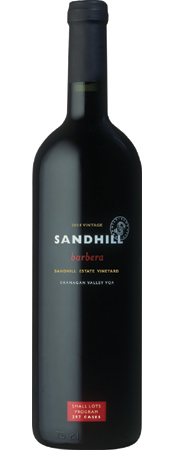

Sandhill
2004 Barbera - Small Lots, Sandhill Estate Vineyard(Okanagan Valley)
When Sandhill released its initial 2000 vintage of Barbera, the winery noted: “Since 1995 Barbera has proven to be the most successful Italian grape variety grown at our [Sandhill Estate] vineyard.” The suggested reason: the grape grows in one of the hottest spots in this deep, sandy vineyard, next to a cliff. Winemaker Howard Soon explains: “The accumulated heat offered by the cliff allowed full development of aroma and flavour.”
This is the oldest block of Barbera in the Okanagan; perhaps it is the only one. Very few other growers have taken a chance on Italian reds, playing it relatively safe with Bordeaux reds and Syrah – which also occupy the major acreage in the Sandhill vineyard. Hats off to Sandhill – its gamble allows Soon to craft several interesting Italian-styled wines.
This is a bold, dark Barbera, with dollops of plums and prunes on the palate. On the aroma, there is plum, chocolate and earthiness. The wine is full-bodied with an attractive spicy finish. The appeal of this wine is its robust rusticity. This is a man’s wine. 297 cases. 87 points.
Reviewed April 5, 2007 by John Schreiner.
Other reviewed wines from Sandhill
|
Sandhill 2005 Barbera - Small Lots, Sandhill Estate Vineyard (Okanagan Valley)John Schreiner 3/28/2008 |
|
Sandhill 2005 Sangiovese - Small Lots, Sandhill Estate Vineyard (Okanagan Valley)John Schreiner 3/28/2008 |
|
Sandhill 2005 Petit Verdot - Small Lots, Phantom Creek Vineyard (Okanagan Valley)John Schreiner 2/22/2008 |
|
Sandhill 2004 Sangiovese - Small Lots, Sandhill Estate Vineyard (Okanagan Valley)John Schreiner 4/5/2007 |
|
Sandhill 2004 Cabernet Sauvignon-Syrah - Small Lots, Sandhill Estate Vineyard (Okanagan Valley)John Schreiner 3/14/2007 |
|
Sandhill 2004 Petit Verdot - Small Lots, Phantom Creek Vineyard (Okanagan Valley)John Schreiner 2/6/2007 |
The Wine
Winery: Sandhill |
The Reviewer John Schreiner
John Schreiner
John Schreiner has been covering the wines of British Columbia for the past 30 years and has written 10 books on the wines of Canada and BC. He has judged at major competitions and is currently a panel member for the Lieutenant Governor’s Awards of Excellence in Wine. Both as a judge and as a wine critic, he approaches each wine not to find fault, but to find excellence. That he now finds the latter more often than the former testifies to the dramatic improvement shown by BC winemaking in the past decade. |





























